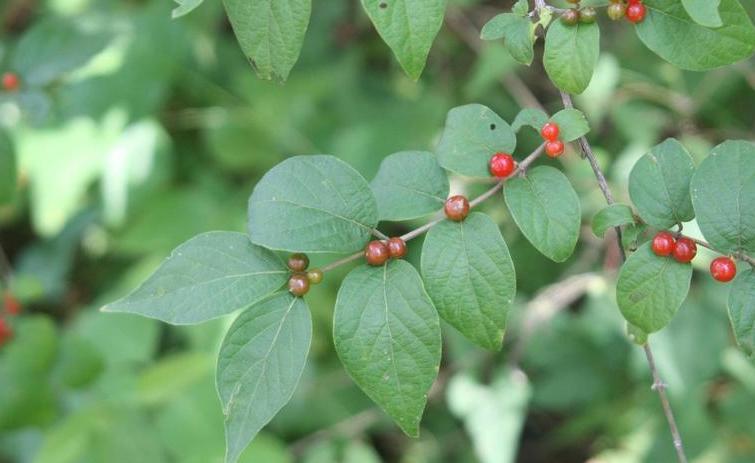About exotic bush honeysuckles
Life cycle and background
Bush honeysuckles (Lonicera maackii, L. morrowii, L. tatarica, L. xbella, L. fragrantissima) are perennial deciduous shrubs that were used for ornamental gardens and soil erosion control. They are now found growing in dense sprawling thickets that out-compete native plants for soil moisture, light, and nutrients. The effect of pollinators favoring the flowers of exotic honeysuckles results in reduced fertilization and seed set among the native species. Higher populations of lone star ticks have been found in association with Amur honeysuckle (Lonicera maackii). Chemicals in L. maackii inhibit the growth of other plants. Berries of the exotic honeysuckles lack the high-fat content migratory birds need for long flights.
As of February 2018, the Maryland Department of Agriculture classified Amur honeysuckle (Lonicera maackii) as a Tier 1 invasive plant in Maryland. A person may not propagate, import, transfer, sell, purchase, transport, or introduce any living part of a Tier 1 invasive plant in the state.
Growth habit
Fast growing and invasive deciduous shrubs grow up to 20’ in height. Leaves are opposite on the stem. The invasive honeysuckles have tubular fragrant flowers ranging from white to yellow or white to pink in color. Flowering begins in early spring before many native shrubs. Pith inside the stem is hollow. (In native Loniceras, the pith is solid.) Fruits are red to yellow.

Reproduction
Seeds are dispersed long distances by birds and deer.

Conditions that favor growth
Exotic honeysuckles prefer sunny sites such as forest edges, pastures, roadsides, and open woodlands.
What to plant instead
Trumpet honeysuckle (Lonicera sempervirens), red or black chokeberry (Aronia arbutifolia or Aronia melanocarpa).
Controlling Invasive Honeysuckles
- Invasive Shrub Control
- (PDF) Control of Invasive Non-Native Plants
- (PDF) Plant Invaders of Mid-Atlantic Natural Areas
- Shrub Honeysuckles | Penn State Extension
Additional resources
Kaufman, Sylvan Ramsey & Wallace Kaufman. 2007. Invasive Plants: Guide to Identification and the Impacts and Control of Common North American Species.
Maryland Invasive Plants Prevention and Control, Maryland Department of Agriculture.
Maryland Invasive Species Council. May 2018. “Are Invasive Plants “Bugging” You?”
Sarver, M. J., A. Treher, L. Wilson, R. Naczi, and F.B. Kuehn. 2008. Mistaken identity? Invasive Plants and Their Native Look-alikes: an Identification Guide for the Mid-Atlantic. Dover, DE: Delaware Department of Agriculture and USDA Natural Resources Conservation Service.
Swearingen J., K. Reshetiloff, B. Slattery, and S. Zwicker. 2002. Plant Invaders of Mid-Atlantic Natural Areas. National Park Service and U.S. Fish & Wildlife Service, Washington, DC.
Compiled by Christa Carignan, reviewed by Debra Ricigliano, University of Maryland Extension, 5/2018
Still have a question? Contact us at Ask Extension.
